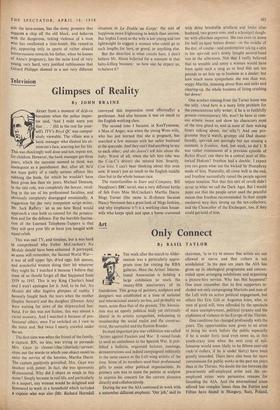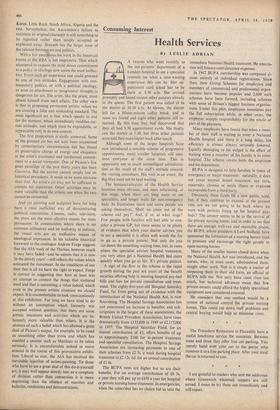Art
Only Connect
By BASIL
TAYLOR THE week after the march to Alder- maston was a particularly appro- priate time for visiting the RBA galleries. Here the Artists' Interna- tional Association is holding a large exhibition to mark the twenty-fifth anniversary of its foundation. This group of painters, sculptors and designers was established at a time of national and international anxiety no less, and probably no more, acute than that of the present. The Associa- tion was an openly political body yet extremely liberal in its artistic sympathies, welcoming to membership the social realist and the construe- tivist, the surrealist and the Euston Roader.
Its most important pre-war exhibition was called 'Artists against Fascism and War.' It raised funds to send an ambulance to the Spanish. War. It pub- lished a bulletin, organised lectures, meetings, demonstrations and indeed campaigned militantly in the same causes as the Left-wing writers of the time. Some of its members used:their professional gifts to assist other political organisations. Its primary aim was to assist the painter or sculptor to express his concern for the current situation directly and collaboratively.
During the war the AIA continued its work with a somewhat different emphasis. 'Our job,' said its chairman, 'is to try to ensure that artists are not allowed to starve and that culture is not annihilated.' In the past ten years the AIA has given up its ideological programme and concen- trated upon arranging exhibitions and organising a picture-hire service. Why has this happened? One must remember that its first supporters in- cluded not only campaigning Marxists and men of the Left with an active political engagement, but others like Eric Gill or Augustus John, who, as men of good will, were offended by the spectacle of mass unemployment, political tyranny and the explosion of violence in the Europe of the Thirties.
One condition has changed profoundly with the years. The opportunities now given to an artist to ,bring his work before the public especially if he is under forty (and even more so, in this youth-crazy time when the next crop of mil- lionaires would seem likely to be fifteen-year-old rock-'n'-rollers, if he is under thirty) have been greatly extended. There have also been far more commissions for public works in the past ten years than in the Thirties. No doubt the ties between the precariously self-employed artist and the un- employed miner were persuasive reasons for founding the AIA. And the international scene offered less complex issues than the Forties and Fifties have found in Hungary, Suez,' Poland, Korea, Little Rock, South Africa, Algeria and the rest. Nevertheless, the Association's failure to maintain its original character is still something to be regretted rather than simply accepted or explained away. Beneath lies the larger issue of the relation between art and politics.
With a few exceptions the work in the historical rooms at the RBA is not impressive. That which attempted to express the most/direct commitment to a policy or ideology now seems the most ineffec- tive. From such an experience one could proceed to one of two attitudes. Engagement with con- temporary politics, or with a political ideology, or even an attachment to 'progressive' thought, is dangerous for art. The artist, like the priest, must absent himself from such affairs. The other view is that in proposing permanent artistic values we are creating a false and misleading standard. The most significant art is that which speaks to and for the moment, which immediately modifies cur- rent attitudes, and which must be expendable, or appreciable only in its own context.
The first proposition is easily answered. Some of the greatest art has not only been occasioned by contemporary circumstances but has found its preservative charge of energy and eloquence in the artist's emotional and intellectual commit- ment to a social viewpoint. One of Picasso's few great paintings of the past thirty *years has been Guernica. But the answer, cannot simply rest on historical precedents. It needs to be more intricate than that. An artist's art may not be sufficient to contain his aspiration. Other activities may be more valuable than the artistic one when the two cannot be connected.
And yet painting and sculpture have for long been a most inefficient way of demonstrating political convictions. Cinema, radio, television, the press are the most effective means for mass persuasion. In communities where there is no common orthodoxy and 'no authority to enforce, the visual arts are an ineffective means of ideological expression. In his valuable historical foreword to the catalogue Andrew Forge suggests that the ALA work of the Thirties, however much it may have faded—and he admits that it is now `in the dowdy years'—still reflects the values which animated the movement. In the conditions of our time that is all we have the right to expect. Forge is correct in suggesting that here at least was an attempt to connect the things that, mattered most and that is something, a value indeed, which even in the present artistic situation we should expect. It is uncomfortable to look conscientiously at this exhibition. For long we have tried to do without an assumption which formerly was accepted without question, that there are some artistic intentions and activities which are in- herently more valuable than others. It is the absence of such a belief which has allowed a great deal of Picasso's output, for example, to be rated as something other than trivia and which has enabled a painter such as Matthieu to be taken seriously. It is uncomfortable indeed to move around in the rooms of this provocative exhibi- tion. Liberal as ever, the AIA has received the inevitable injection of action-painting. To those who have to see a great deal of this do-it-yourself art, it may well appear dowdy too; as a symptom of division rather than connection it is more depressing than the absence of marches and bulletins, resolutions and demonstrations.





























 Previous page
Previous page